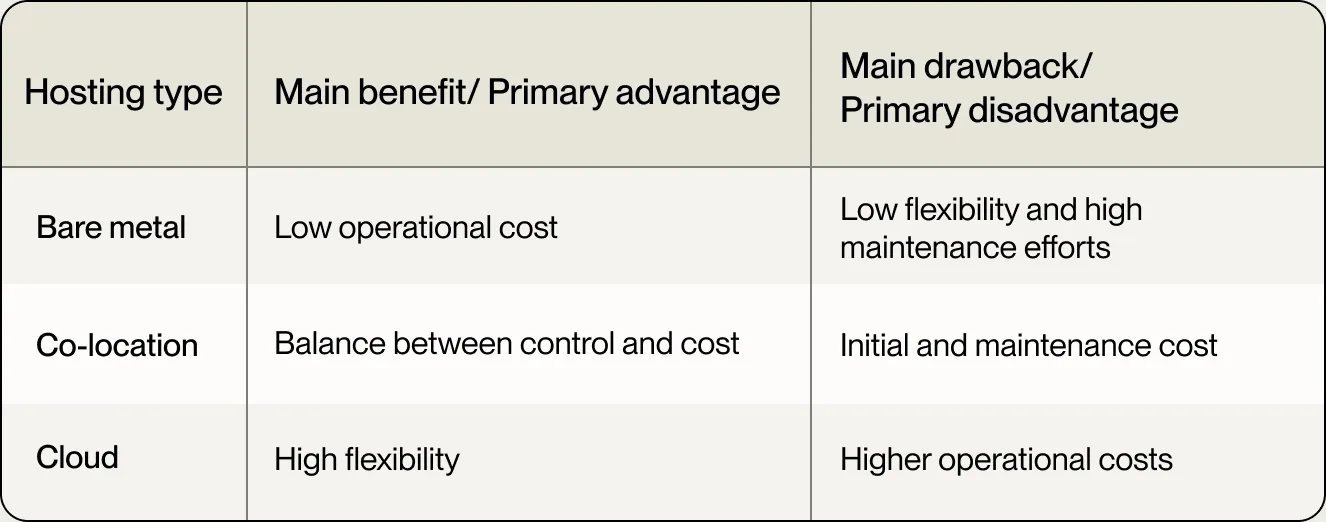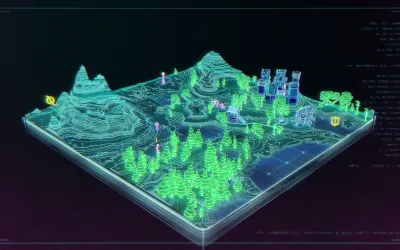In the first blog post of our mini-series aptly named Multiplayer Development 101, we introduced some of the challenges of online multiplayer development and explained why different game genres have different requirements.
In this post, we’ll cover the important topics of hosting and planning. We’ll also offer a glimpse into the ever-evolving landscape of multiplayer development.
Table of contents
Find the other entries here:
Now, let’s dig into it.
The various choices for hosting
The choice of hosting infrastructure is a critical component in the development of multiplayer games, as it has a large impact on operational efficiency, scalability, and overall technical performance. The geographic location of the hosting solution determines latency, an important factor for player experience in real-time games. The debate between Bare metal, Co-located, and Cloud hosting options extends to managing the complexities of multi-region deployment, ensuring players across different geographies experience minimal latency.
Bare metal
Bare metal servers offer dedicated hardware resources, providing the highest level of performance and control. This option is ideal for games that demand high computing power and low latency, such as fast-paced action games or large-scale MMOs. However, the challenges lie in the significant upfront investment, the need for in-house technical expertise for maintenance, and limited scalability. Geographical location can also be a limitation, as server location directly affects latency for players in different regions.
Co-located
Co-location involves renting space in a data center where you can install your own servers. This option offers a balance between control and cost, allowing game developers to leverage the advanced infrastructure of a data center while maintaining ownership of their hardware. Challenges include the need for initial hardware investment, ongoing maintenance, and the potential for scalability issues. Like bare metal hosting, server location remains a critical factor for global accessibility.
Cloud
Cloud hosting has become increasingly popular due to its scalability, flexibility, and reduced need for physical infrastructure. It allows games to scale resources up or down based on demand, making it suitable for games with fluctuating player bases. However, this option can introduce challenges in terms of higher ongoing costs, especially under a pay-as-you-go model. Additionally, developers must consider network performance and security aspects, as cloud environments can be complex to configure and secure.
Which hosting option should I choose?
Each hosting option requires careful consideration of the game’s specific needs and resources. Additionally, developers must consider issues like disaster recovery, data backup, and the ability to address hardware failures, which are crucial for maintaining a stable and reliable gaming environment.

Team and planning challenges
Creating a multiplayer game encompasses more than just technical challenges: it demands the orchestration of various specialist roles, each bringing essential skills to different development phases. The need for diverse expertise, from Network Programmers and Cloud Architects to Operations Managers and Security Specialists, introduces significant challenges in recruitment, cost management, and workload distribution. Securing individuals with these specialized skills can be time-consuming and costly, elevating the overall production expenses. For smaller game studios, this task is further complicated by limited resources and reduced market presence.
Assembling the right team to develop an online multiplayer game can be both challenging and costly.
The development process of a multiplayer game requires different team roles and skills at different stages during the initial setup and later phases. Managing these varying demands without wasting resources or money requires strategic planning and adaptability. This is important for ensuring game quality and avoiding problems that can affect the player experience.
In addition to managing team roles and skills, the pre-production phase of game development is filled with crucial decision-making. Choices made during this early stage set the trajectory of the entire project. However, these decisions also bring the risk of costly adjustments down the line. Changing key aspects of a game after exiting the pre-production phase can be costly, as it often involves revising significant portions of the work. This challenge highlights the importance of careful planning and informed decision-making early in the development process to minimize the need for resource-intensive revisions later.
The evolving landscape of game development
Multiplayer game development is a fluid and evolving journey. Initial concepts often undergo significant transformations. This dynamic nature of game creation stems from several factors, including:
- Changing requirements
- Shifting market trends
- Evolving player expectations
- Emergence of new distribution channels
Developers must remain agile and adaptable, ready to pivot or iterate on their designs to meet these changing conditions.
Moreover, the market for games is constantly evolving, with new genres emerging and player preferences shifting. Therefore, game developers need to not only be creative but also perceptive to the trends and preferences of their target audience, as this can determine the success or obscurity of their games.
The introduction of new distribution platforms and models, such as digital storefronts, subscription services, and free-to-play models with in-game monetization, has also reshaped the landscape. These platforms offer new opportunities but also present their own set of obstacles in terms of monetization strategies, continuous content delivery, and community engagement.
In summary, the fluidity of game development, marked by its constant evolution and adaptability, sets it apart from more structured creation processes. Embracing this dynamic nature is key for developers aiming to craft successful and engaging multiplayer games in a rapidly evolving industry.
Reimagining multiplayer development with Lemur
All the above serves as a great context as to why Ringtail Lemur – a fully managed online multiplayer development platform – exists. Looking ahead, Lemur changes the game development process by efficiently taking away the most overwhelming technical considerations. This not only liberates developers to focus their creativity on game design but also results in significant time and cost savings, accelerating the time to market for new games.
Lemur enhances multiplayer game development by providing a range of ways to facilitate developers, including but not limited to:
-
A fully managed cloud solution: which alleviates the arduous task of managing and scaling resources for multiplayer games.
-
Developer-friendly tools: that integrate with game engines and consolidates implementation, allowing developers to channel their talents into the essence of game features and player experience, while also ensuring a more efficient and economical development cycle.
-
Versatile toolkit: rather than offering a rigid, one-size-fits-all solution, Lemur offers something like a set of customizable building blocks, allowing developers to customize their projects according to their specific visions and requirements.
With Lemur, the journey from a game concept to a fully functional multiplayer experience involves both creative exploration and efficient and economical realization of these ideas. We are dedicated to ensuring that technological challenges are no longer a barrier but a facilitator for innovative and cost-effective game development. In simple terms, we’re here to reimagine multiplayer development.
Want to learn more about Lemur’s core concepts? Check it out:

